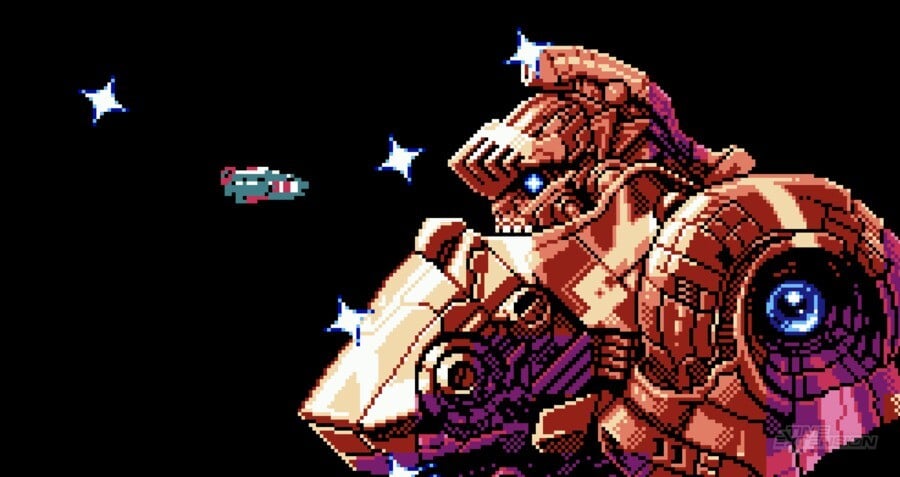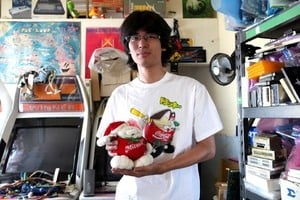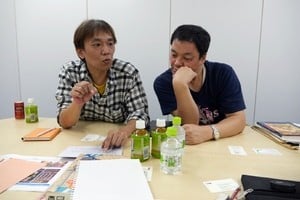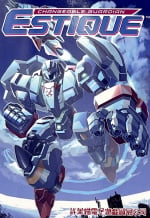
It's an exciting period to be an enthusiast of old hardware, as the homebrew community makes use of modern technology plus decades of experience to create a wealth of new releases. Recent examples have included Space Hunter on Mega Drive, a port of Konami's Asterix to the SNES, and Dangan GB 2 on the Game Boy Color. Today, we bring news of Chouyoku Senki Estique on Famicom, anglicised as Changeable Guardian Estique. What a time to be alive!
It's being designed by Takayuki Komabayashi and his new company, Cat Hui Trading LLC. You may recognise Komabayashi from The Untold History of Japanese Game Developers Volume 3, where he was interviewed, and various articles on Time Extension where he acted as a consultant. As an expert on Japanese retro games, he previously invented a variety of bubble wrap, adopted by the industry to protect arcade PCBs, was in charge of Beep Shop's arcade PCB sales department, and later joined M2 and worked as part of the team which brought us the Mega Drive Mini.
The demo for Estique is extremely impressive. The ROM of this was sold at the Digigame Expo 2023 for 500 Yen (about £2.60), which also came with a cartridge sticker. We were sent a free copy for preview purposes.

Players have four selectable speeds (select button), and they can transform between a fast ship (horizontal hitbox) and a slower mecha (vertical hitbox) using the B button. Firing is done with the A button. There are two distinct weapons you can collect: the first is B (short for B.I.T.), which gives you a standard forward projectile and two rotating satellites; the satellites absorb enemy projectiles and damage enemies. The second weapon is W (Wave), which fires a three-way spread shot but lacks the satellites. What sets Estique apart from other shmups is its special attack system, the unique characteristics of each form, and the lives system.
Firstly, there are no lives, only a single shield. If the shield is depleted, it's game over – however, transforming into the slower mecha will replenish the shield in increments, roughly every 10 seconds. The downside is your hitbox is less manoeuvrable and your special attack less versatile, so there's a fun risk/reward balance as you clear enemies and transform, using less intense periods to replenish before the next onslaught.
As for the special attacks, there are no screen clearing power-bombs. Double-tapping the fire button in ship form will boost your attack power, offering larger and faster projectiles; if you've got the satellite weapon, they will spin around your ship much faster, effectively making you invincible. This 'Super-Saiyan' steroid boost lasts only a short while, so it is best saved for when overwhelmed by enemies. In mecha form, double-tapping fire releases an ultra-powerful wave punch, which travels a short distance. It's good, but not as useful as the ship's special attack. You can collect up to six of these special attacks, and success requires juggling your selected speed, form, shield replenishing, weapon type, and this limited supply.
The demo is only a stage long and ends with an enormous screen-filling boss. He's not very challenging, but take a look at the screenshots – the design and sprite art is exquisite.

"I realised that as a company employee, I would never be able to make the kind of game I wanted to make," Komabayashi tells us. "Whereas with my own company and funds, I could make whatever I wanted, so the name, transforming robots, gals, Hong Kong background, Gunkan March music for the title screen, and all of its unique personality are in the game. The refreshing feeling to be using our own copyrights, with no supervision, no confirmation, no offers, and no ties, is a comfort. The demo was well received and sold very well. I will continue to work hard until the completion of the project."
Assisting Komabayashi are three shmup veterans from Compile, each with prominent portfolios.
Takayuki "Jemini" Hirono is Estique's programmer, famous for creating Zanac, the Aleste series, The Guardian Legend on NES, and GunHed / Blazing Lazers on PC Engine. We've had interviews with him before and by all accounts, he is a genius programmer.
Hiroki "Daigattai" Kodama is in charge of production design, and his credits include Power Strike II for Game Gear and Spriggan Mark 2 on PC Engine CD-ROM.
Satoshi "Pac" Fujishima is assisting; he's a long-time friend of Hirono's, and you may recognise the name as the creator of Golvellius, and from our SG-1000 article, given he programmed the system's incredible shmup Gulkave.
"This is the first time Jemini Hirono has made a Famicom game in 30 years," explains Komabayashi, describing the challenges. "Building a development environment in Windows and trying to remember 2A03 assembler are the biggest, I think. There is a market for homebrew Famicom games, but also developing for Famicom means we can have a smaller team than for something like the Mega Drive, and we can finish the game more quickly. The final game will contain six stages with an abundance of high-quality graphics. For example, we achieved the impression of more colours by layering multiple sprites. The final game will be 3 Megabits, the same size as Jarinko Chie by Konami."
We have to pause for a second, given Komabayashi references the old "Megabit" size once used for cartridge games. However, the comparison is accurate, given Jarinko Chie contained 384kb of combined memory.
If you've read Komabayashi's previous interviews, you'll know his favourite game is the arcade shmup Equites by Alpha Denshi. His own shmup pays homage by having its title, Estique, be an anagram. There are also some obvious gameplay influences, such as Thexder (the computer version, not the butchered Famicom port), Hyper Dyne Side Arms, and Volguard II. But it stands out by featuring several less common mechanics, notably its unusual special attack system and the fact his team are throwing themselves into it to make the game they want, rather than a game which caters to any specific expectations. A good example is the title screen, which uses the Gunkan March. The original marching music was composed in 1897, and to our ears, doesn't quite fit the techno sci-fi aesthetics of the game itself. But Komabayashi specifically wanted it, and we have a sincere respect for anyone who sticks to their creative vision. We can only hope the final game is unashamedly self-indulgent.
What excites us most about the game is the complete lack of sprite flicker. If you've played the FC or NES you'll know this is an inherent aspect of how the system's PPU functions – it allows no more than eight sprites on a line. Modern emulators can disable this to remove flickering, and you may think this is what was done for the screenshots. But we can confirm no sprite flickering when run on real hardware – and we really tried to break it! First, by not shooting enemies, so as many as possible were onscreen along with their projectiles, and then by firing our weapons obliquely so as not to hit enemies, but simply clutter the screen. Running on a PowerPak flash cartridge, on a stock NTSC-U NES at 60Hz, there was no noticeable sprite flickering or slowdown. The power-up icon occasionally flashed, though this appeared related to it changing its attributable weapon.
It is genuinely astounding. We asked Komabyashi how Hirono achieved this, though he only replied briefly, "By using double buffering." This page details double buffering on a Game Boy, but makes reference to both the NES and C64 in its explanation. The static screens around this page don't do it justice, or how much can end up onscreen at any one time. The trailer, captured on original hardware, showcases it nicely:
Sadly, we did encounter a bug. While the demo is reported to run perfectly on the latest Everdrive flash cartridge, and most good emulators, on our outdated PowerPak, the title screen and boss graphics were garbled. This cartridge stopped receiving support years ago, unlike the Everdrive, and there are several titles it has trouble with. There have also been reports that the emulator in the Famicom Mini has the same graphical glitches. The main level, however, works fine.
Komabayashi and his team have been developing the game since February, with plans to finish by summer 2024, this simply being its first public reveal and demo. So, there is plenty of time to iron out any reported bugs – and hopefully expand the music, too. Currently, it's a bit limited. You can access it via the options menu.
We tested it on original hardware on a CRT TV, and the inherent nature of using AV cables resulted in the usual dithering of pixels, which generally produces a nice effect with FC / NES games, giving the faux impression of greater colour depth. We've included two direct capture images, because the emulated screens are a little too clean. We asked if the team was specifically taking this into account, or if they were developing under the assumption most players would use modern screens?
"We actually don't think what kind of monitor players will be using," reveals Komabayashi. "The graphics are nice enough on modern screens, but if you still have your CRT it will be a little bit nicer."
As for the final release, we broach the subject of platform. Will it be exclusively on Famicom cartridge, or could we see it on Steam or Nintendo Switch? Has he contacted somewhere like Limited Run Games? As Komabayashi explains, "It depends on finding a publisher. I've emailed several, and included links to the YouTube video. If you contact someone like to Limited Run Games, please tell them that there is a nice NES game in development." He then adds the team can be contacted via their website and Twitter. They also welcome feedback and comments.

Finally, given that we've been friends with Komabayashi for over a decade now, we couldn't resist mildly teasing him about the weapons system. In Japan, one of the biggest icons of the Famicom era was Takahashi Meijin, an employee at Hudson who would star in Adventure Island. He was famous for excelling at Famicom shmups like Star Soldier and being able to hit the fire button 16 times per second. His ability became legendary among Japanese players, with Hudson even releasing a device to practice on, plus a rapid fire controller called the Joycard Mk2, which was advertised as allowing you to be just like Takahashi Meijin. Given how intrinsically linked this whole phenomena is to the zeitgeist of Famicom shmups, forming part of the collective memory of Japanese players, we asked Komabayashi about the fact Estique's weapon system won't work with rapid-fire controllers. We also asked him what Takahashi Meijin might make of it.
"Many Famicom games require a rapid-fire controller, such as Hudson's Joycard Mk2, to beat the game," begins Komabayashi. "Since few people still have a Joycard controller, or anything similar, we decided Estique should not require it to play. Even though rapid firing is not required, there is an exhilarating feeling of destruction, rather than avoidance, so I think Takahashi Meijin would appreciate that. We are developing the game towards a level of difficulty that is comfortable and enjoyable."
Currently, the demo is not available online – for the moment, it won't be, given that it only contains one level and is not indicative of the full game's quality. We'll bring you more updates as they happen.


